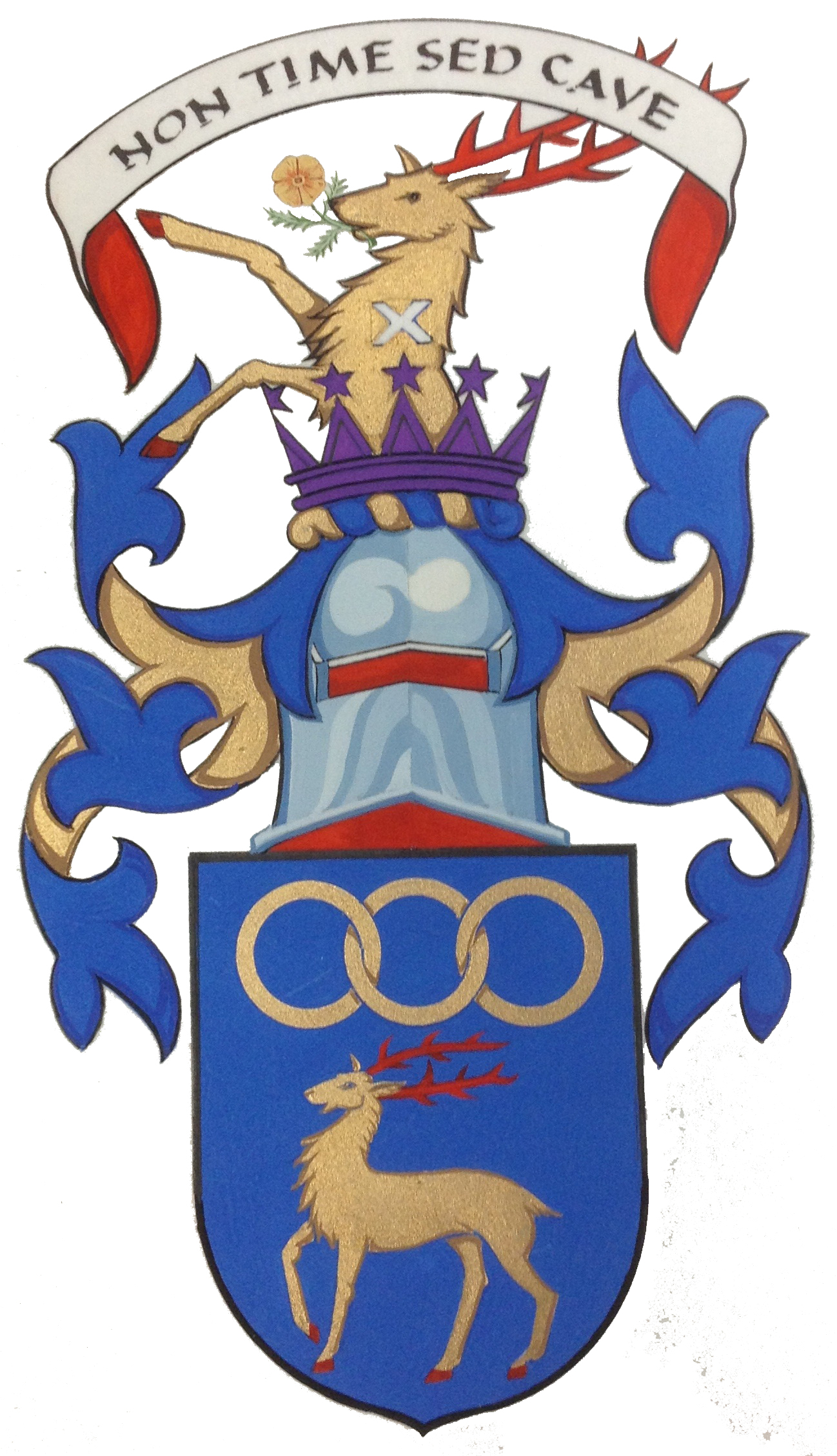|
Strachan of Lenturk
By Jim Strachan,
Esq.
Excerpt from his book, "Here's
Tae Us, Wha's Like Us!: A History of Clan Strachan."
(2009)
The noble family 'de Strachan' were
related to the Great Comyn family. They subsequently
supported the Balliol and Comyn claims to the thrown of
Scotlan; and opposed Robert the Bruce.
At the
Battle of Inveruriein 1308, forces
loyal to the Bruce triumphed over the Comyns and their
allies, killing them or driving them into exile.
In 1315,
the King Robert I (The Bruce) disinherited the 'de Strachans',
confiscated their lands, and shortly thereafter the
baronetcy of Strachan was granted by King Robert I to Sir
Alexander Fraser, his brother-in-law, and the Great
Chamberlain of Scotland.
In 1341, King David
II (Bruce's son and heir), had been defeated and captured by
the English at the Battle of Neville's Crossf
one King could disinherit them, why should not another? With
a little persuasion King David reinstated the Strachans,
among others.
Shortly thereafter, between
1347-1355 all families that benefited from lands of the
disinherited Strachans quickly rushed to make amends. Six
descendants of the former de Strachan nobles received lands.
About 1350, Sir JohnStrachanwas granted the
lands of Lenturk,
which, like Glenkindie, was situated quite near to the Earl
of Mar’s fortress,
Kildrummy
Castle.
In 1359, Sir John became Sheriff
(Viscount) of Forfarshire.
In official
documents of the time, we find him listed as a witness to
the installation of John of Mar as Bishop of Aberdeen; and
to another charter, as co-witness with William Keiththe Earl Marshall.
In 1380, he granted the lands
of Petgervy to his son Galfrid.
2nd of Lenturk - Alexander Strachan
The House of
Lenturk continued with Alexander(c1390-1440).
3rd Laird of Lenturk - Thomas
The 1500’s opened with Alexander
Strachan as Laird of Lenturk.
He was succeeded in 1526 by his
son Thomas,
who married the daughter of William Forbes of Ardmuro,
fl 1522.
Forbes’ other
daughter married Thomas Lumsden of Cushnie.
4th Laird of Lenturk - The Rascal
John Strachan
Thomas’ son and
heir, John Strachan (the 4th
Laird of Lenturk) was a notoriously bad character (according
to some).
The
Castle
of
Lynturk
was built by John Strachan in 1514 [Laing 1828].
Mentioned in 1612 by
Monnipennie as one of the strongholds of Mar, and described
in the Statistical Account (OSA) in 1792 as in ruins, having
a deep broad ditch around (NSA 1845).
In 1526, John Strachan of Lenturk, was an
adherent of the house of Forbes (mother was a Forbes), a
connection of the Lumsdens, and even by the standards of the
times a man of unsavoury reputation.
In pursuit of the
old quarrel between the Forbes and the Leslies, John
Strachan of Lenturk and John Forbes,
the Master, murdered Alexander Seton of Meldrum.
According to Laing
(Dunean Tourist, pg. 379), in 1526, a clan war broke out
between the families of Forbes and Leslie, when many murders
were committed by Mar, Garioch, and Aberdeen; but after the
assassination of Meldrum or Meldrum, by the Master of
Forbes, and John Strachan of Lenturk, a lasting peace was
cemented.
For his part in this crime Forbes
obtained a remission from the King in 1530. John Strachan of
Lenturk who was also guilty of sacking the
castle
of
Kildrummy,in addition to
being implicated in the murder of John King of Bourtie
did not obtain
his remission for the murder of Seton until the following
year.
Five years later (1537) an even more
serious charge — that of conspiring to shoot King James V
with a culverin in the course of the King’s visit to
Aberdeen
— was brought against the two men. (Thornton-Kemsly, Colin.
“Bonnet Lairds”.
AND
Slade, H. Gordon, “Tillycairn castle, Aberdeenshire”)
Or, rather the
charge was leveled against John Forbes, and the lesser
charge of
foreknowledge and treasonable
concealment was brought
against Strachan. Strachan “and
his notorious rebels”
outlawed.
For this Strachan was convicted and
pardoned subject to him keeping himself beyond the 'Waiter
of Dee',
and in the event of the King
crossing the river putting a space of 12 miles between
himself and his sovereign. John Forbes, however, was
executed.
There is a tradition that Strachan had
asked for some favour, which Forbes had been unwilling or
unable to grant. This had so enraged Strachan that to obtain
his revenge he had invented the whole conspiracy. Strachan
knowing Lord Huntly to be at variance with John Forbes, had
taken to false accusation against him. To add color to the
charge it was said that Forbes hoped that in accomplishing
the King's death
'the Dowglasses
might be restor'd to their ancient
possessions, titles, and honour'.
Versions of this story are recorded by both George Buchanan
and David Scott.
It is worth remembering that in the
same year that John Forbeswas beheaded for
his apparent assassination attempt of King James V, his
wife's sister-in-law Janet Douglas,
Lady Glamis, was also burnt alive for conspiring against the
King. From these tragedies sprang the bitter enmity between
the Forbes and Gordons that was to convulse the northeast
for the rest of the century.
It goes without
saying that Strachan of Lynturk ceased to be an adherent of
the House of Forbes,
and devoted much of his not inconsiderable talent for
creating mayhem to the lands of that family and its
adherents.
In the course of
time his attention was attracted to Tillycairn castle, which
lay near to his land, and in June 1542 Matthew Lumsden found
himself lightened of 19 plough oxen, eight cows and two
three-year old stirks [a heifer or bull]. As compensation
the Queen Regent granted to Matthew Lumsdenin 1548 the lands
of Little Lenturk and Bridgend, together with the alehouse
and alehouse croft that had belonged to John Strachan.
In 1546, John inherited the lands of
Lenturk upon the death of his father.
Lumsden could
hardly have felt very secure of this grant until seven years
later when Strachan left
Scotland
for good.
Almost his first
act after inheriting Lenturk was to sell what was left of
the entire lands and estate to his kinsman and namesake,
John Strachan, Baron of Thornton.
The deed of sale was witnessed by
several of the Strachan Lairds including John Strachan of
Monboddo,
John Strachan of Dullivard, and
William Strachan of Tipperty.
The purchase of
Lenturk gave rise to litigation, the Queen’s Advocate
alleging that the sale was without reversion, and that John
Strachan of Lenturk forged his cousin’s signature (Strachan
of Thornton) on a document securing the reversion of the
property back to him upon
Thornton’s
death.
Before judgment was entered,
John Strachan of Lenturk recanted is testimony, and
confessed to the forgery and admitted that the sale was
unconditional.
John appears to
have continued his lawless ways for another nine years
before finally being captured in 1555, 24 years after he had
first been outlawed as a freebooter.
He was brought before Queen Mary of
Guise and charged with “many
crimes, including the burning of
Kildrummy
Castle,
particularly against William Lord Forbes, Master Duncan
Forbes and John Forbes, his brother.”
Like many clan
battles in those turbulent times, one side was probably as
guilty as the other and the bold John Strachan may well have
been as much sinned against as sinning.
Moreover, to have mustered the
strength to sack and burn the great
Kildrummy
Castle,
argues that he must have had a considerable following.
Queen Mary was thus
faced with the choice of appeasing the powerful Forbes clan
by executing Strachan (and thereby alienating the Strachans),
or of pardoning Strachan and alienating the Forbes.
She compromised, pardoning John
his life on condition he signed an agreement to leave
Scotland
forever.
This he must have done, for that is the
last we hear of this wild chieftain, the last of the
Strachans of Lenturk, a house that had lasted almost exactly
200 years.
As for the lands of the House of Lenturk,
acquired by the Strachans of Thornton, they were sold 50
years later by Alexander Strachan of Thornton, to Alexander
Irving and his wife Agnete Forbes, a sale that presumably
consolidated the paramountcy of the Forbes in that area.
Lynturk
Castle
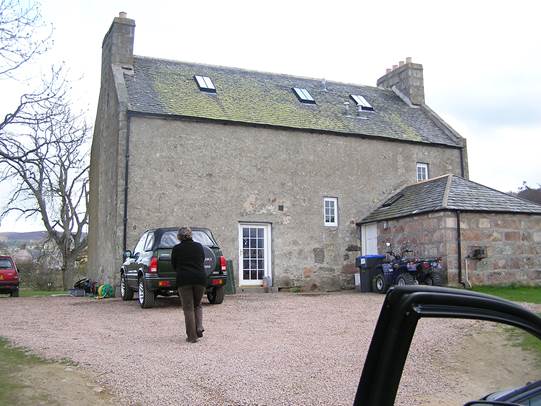
Lynturk
Castle,
alternatively known as Castleknowe of Lynturk, is located in
Aberdeenshire.
One approaches the current site down a
dirt road, and enters the driveway.
As shown above, one drives up
to a gaunt three-window two-story farm house. A storage area
or garage, shown above in the bottom right corner, is new
thought to be built in the 1990’s.
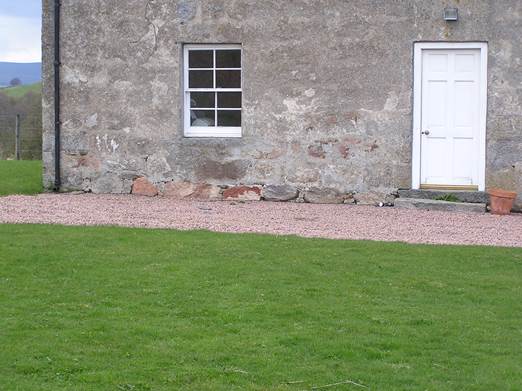
As shown above, the house was built on the framework of the
15th century
Lynturk Castle.
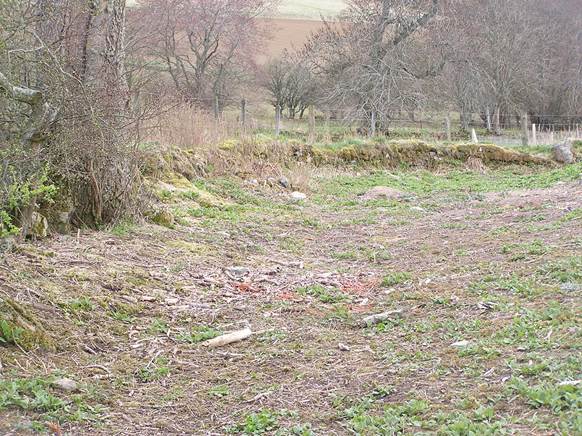
The southeast ditch (gun loop),
pictured on the previous page, encloses an area of 125 ft.
in diameter, which now stands on the farmhouse.
The east arc of the ditch has
disappeared completely.
The north arc is only
discernible as a very faint hollow.
Elsewhere it has been preserved
by the erection of a garden wall.
The recess of the gunloop
measures 1.0 to 1.5 meters wide.
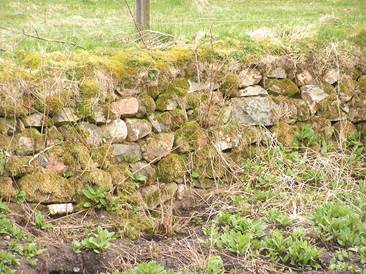
The above are pictures of
Lynturk Castle’s
gun loop, and are now located in the home’s backyard.
As you turn back towards the home, you
immediately notice a deep contrast between the facade of the
front, and rear of the house.
It soon becomes quite apparent
that like other Strachan sites, the now current front of the
house was once the rear.
Pictured below is the current
rear of the house.
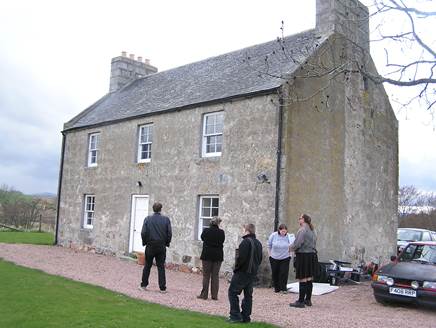
Many of the original stones of
Lynturk
Castle
have been re-used to erect the now
ruined
Secession
Church
dated 1762 (NJ5987 1223; New Statistical Account “NSA’ 1845;
WD Simpson 1949; A Laing 1828).
|
